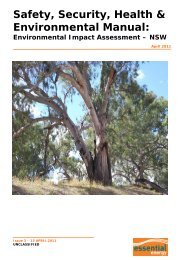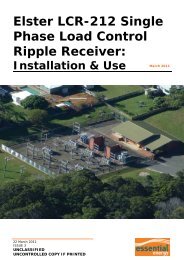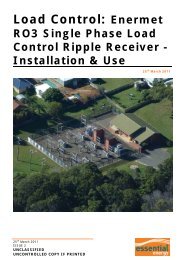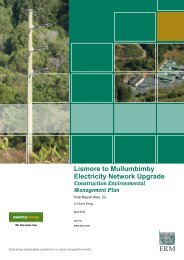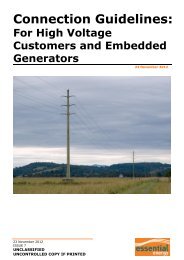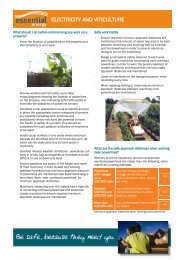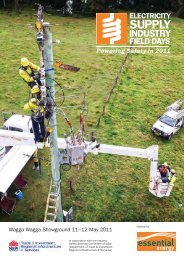Full Version - Essential Energy
Full Version - Essential Energy
Full Version - Essential Energy
Create successful ePaper yourself
Turn your PDF publications into a flip-book with our unique Google optimized e-Paper software.
30<br />
<strong>Energy</strong> efficiency research<br />
scholarship<br />
A research scholarship focusing on energy efficiency<br />
has been established by Country <strong>Energy</strong> and Charles<br />
Sturt University. The successful applicant will research<br />
ways to improve the use of energy in rural and regional<br />
areas, with a focus on marketing and economics issues.<br />
Focus areas will include electricity demand<br />
management options, demand for renewable energy<br />
and ways to increase customer acceptance of energy<br />
efficiency options and renewable energy. This will<br />
help us investigate attitudes toward energy use and<br />
conservation, make better planning decisions and<br />
ultimately reduce energy costs and greenhouse gas<br />
emissions.<br />
Landmark deal<br />
A significant greenhouse gas abatement initiative with<br />
private forestry developer CO2 Group Limited was<br />
announced in April 2005 – representing the largest<br />
carbon sequestration (capture) deal under the New<br />
South Wales Greenhouse Gas Abatement Scheme.<br />
The unique partnership involves establishing up to<br />
30,000 hectares of Mallee eucalypt trees across<br />
regional New South Wales in 2006, which will remain in<br />
place for 100 years under Greenhouse Gas Abatement<br />
Scheme rules. The trees will be planted in strips<br />
on existing farms to act as natural wind breaks and<br />
control soil erosion. Other benefits include greenhouse<br />
gas abatement, dry land salinity management and<br />
regional employment opportunities during both the<br />
establishment and ongoing support phases.<br />
Future goals – reduce greenhouse gas emissions by<br />
3.2 million tonnes over six years – the equivalent of<br />
taking more than 177,000 cars off the road.<br />
Meeting greenhouse targets<br />
Country <strong>Energy</strong> met all organisational greenhouse<br />
gas abatement goals, Federal Government renewable<br />
energy targets, New South Wales Government<br />
greenhouse gas reduction targets and National Green<br />
Power accreditation targets this year.<br />
During the last compliance period, Country <strong>Energy</strong><br />
sourced 100 per cent of green power sales from new<br />
(post 1997 built) renewable energy generators, including<br />
wind, solar and hydro. This is 20 per cent above<br />
minimum accreditation requirements.<br />
The Federal Government’s renewable energy target<br />
places a legal liability on wholesale electricity<br />
purchasers to proportionately contribute towards the<br />
generation of an additional 9,500 gigawatt hours of<br />
renewable energy by 2010. Country <strong>Energy</strong>’s target<br />
for the 2004 calendar year was met.<br />
Commenced in January 2003, the New South Wales<br />
greenhouse gas reduction scheme imposes mandatory<br />
greenhouse gas benchmarks on all New South Wales<br />
electricity retailers.<br />
The State greenhouse gas benchmark is set in terms of<br />
tonnes of carbon dioxide equivalent (tCO2-e) per capita.<br />
The initial level set for 2003 was 8.65 tonnes and the<br />
benchmark progressively drops to 7.27 tonnes in 2007<br />
and will continue until 2012.<br />
Our 2004 calendar year target was met, with more<br />
than 80 per cent of contributions coming from landfill<br />
and waste mine gas generators. These generators<br />
prevent ozone depleting gases and are particularly<br />
environmentally-friendly.<br />
Commercial partnerships<br />
We continue to turn green energy into a commercial<br />
reality, by working with developers to secure new<br />
energy supplies that deliver environmental and regional<br />
sustainability benefits. The key criterion for potential<br />
partners is appropriate technologies, expertise and<br />
financial capabilities. Examples include –<br />
Eastern Star Gas – Narrabri Power Station<br />
While all generation technologies have a role to play in<br />
the future, Country <strong>Energy</strong> has a unique perspective<br />
on the commercial development of new gas-fired<br />
generation in regional New South Wales. Gas-fired<br />
power stations have both operational and environmental<br />
advantages in responding to the challenges of rising<br />
electricity demand.<br />
Opened in November 2004, the 10 megawatt Narrabri<br />
power station opened the door for natural gas to be<br />
delivered on a commercial basis from a New South<br />
Wales field for the first time.<br />
We have a 10-year commercial agreement to purchase<br />
all of the energy and associated greenhouse gas<br />
abatement certificates from the new station.<br />
For the next one to two years of full-time operation, the<br />
facility is expected to produce enough energy to power<br />
13,000 homes and greenhouse gas abatement of<br />
36,000 tonnes per annum – the equivalent of removing<br />
12,000 cars from the road.<br />
COUNTRY ENERGY ANNUAL REPORT 2004–2005




